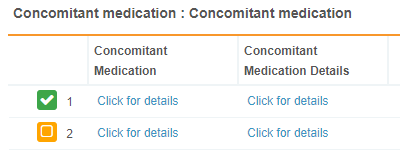New Features: Detail PDFs, Dynamic Event Groups, and more...
Release Date: August 25, 2017Release Date: August 25, 2017
We are pleased to bring you the following new features in this week’s release. See details about each feature’s enablement below.
EDC
Links to Item Groups in Repeating Form Tables
In EDC, a study design can include repeating Forms with repeating Item Groups. When a user views a repeating form in the table view, they can see one column for each repeating item group on that form. Each row in a repeating Item Group’s column contains a link to view the repeating group on its form.
Detail PDFs
In Vault EDC, users can export subject Casebooks and individual Forms to PDF to print or use as a reference. With this feature, users can export detailed PDFs, including both Item values and audit trail entries, at the Form- and Casebook-levels. Users can also choose to include queries in their PDF.
Dynamic Event Groups
In order to support multiple study designs, for example, randomized or adaptive studies, Clinical Programmers can create data validation rules to dynamically add Event Groups to subject casebooks based on conditions. When subject data meets specific rule criteria, Vault EDC automatically adds the Event Group to the subject’s casebook. For example, in a multi-arm Study, Vault EDC can dynamically add the appropriate study arm Event Groups for a subject based on their randomization number. Dynamic Event Groups ensure that data entry users are only presented with the necessary Events and Forms.
Vault Objects
Pass Context into Create & Relate
Vault can simplify data entry processes for users by automatically filling in data. This feature streamlines the create and relate object records process for certain objects. In vaults where two objects share the same parent object and have a relationship to each other, Vault auto-populates the parent object field when using Create to create a record for a sibling object from the context of the related record.
List Navigation for Related Items
In past releases, users could page through a list of related records in most situations, but not for records in a complex many-to-many relationship. This release expands the navigation functionality to support this situation.
Inline Edit of Related Items
Inline grid editing simplifies data entry by allowing users to edit directly in a list. In prior releases, the feature was available within object tabs. This release extends inline edit to related lists that appear with object detail pages. As users update individuals cells within the list, Vault validates and saves their changes.
Additionally, users can now access the same customization options for related record sections as they use for object list pages:
- Change the visible columns to show the most relevant data by choosing Edit Columns from the Actions menu.
- Drag columns to rearrange.
Vault Loader
Vault Loader Success & Failure Log Enhancements
Vault Loader now creates separate logs for successful and failed uploads. Failure logs contain the original data along with the corresponding errors so users can easily review and fix errors. After correcting errors, users can import the failure log itself, rather than updating the original file for import.
Configuration Migration
New Supported Component Types
The following component types are now supported for Configuration Migration and Vault to Vault comparison.
- Document Matching Rule (sharing rules for Dynamic Access Control)
- Jobs
Security
Vault Java SDK Permissions
In this release we’ve introduced four (4) new permissions: Vault Java SDK: Read, Create, Edit, Delete. Although Java SDK is not yet available, these permissions will appear in your vault. To inquire about Vault Java SDK solutions, contact Veeva Services.
Feature Enablement Details
| Feature | Enablement | Application |
|---|---|---|
| EDC | ||
| Links to Item Groups in Repeating Form Tables | Auto-On | EDC |
| Detail PDFs | Auto-On | EDC |
| Dynamic Event Groups | Auto-On | EDC |
| Vault Objects | ||
| Pass Context into Create & Relate | Auto-On | Platform |
| List Navigation for Related Items | Auto-On | Platform |
| Inline Edit of Related Items | Auto-On | Platform |
| Vault Loader | ||
| Vault Loader Success & Failure Logs | Auto-On | Platform |
| Configuration Migration | ||
| New Supported Component Types | Auto-On | All |
| Security | ||
| Vault Java SDK Permissions | Auto-On | Platform |
Enablement Legend
See the following explanations for feature enablement options:
| Enablement | Description |
|---|---|
| Auto-on | Automatically activated and no configuration is required before using the feature; note that in some cases, a new feature is dependent on another feature that must be enabled or configured. |
| Admin Checkbox | Admins must turn on the feature with an Admin checkbox. Note that some “Auto-On” features have a checkbox setting that hides the feature; these will show “Auto-On.” |
| Configuration | Admins must configure the feature (separately from an Admin checkbox) before it is available to use or is active; for example, a Clinical Programmer must create an Item Definition of a certain new Item Type. |
| Support | On/off option controlled by Support. |
